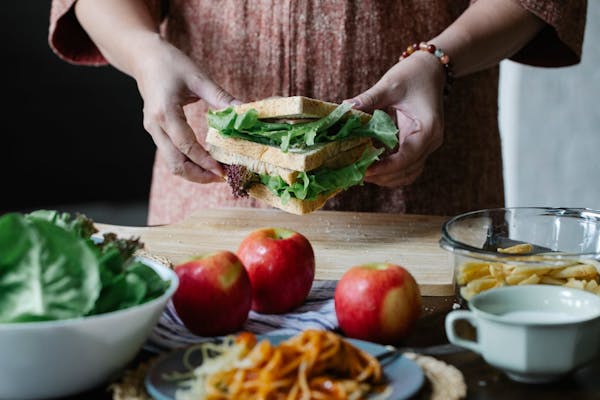Everything You Ever Wanted to Know about Sandwiches (But Were Too Afraid to Ask)

Written by Stephen McCann • March 4, 2024

Look, we get it. While the sandwich may seem like an innocuous lunchtime item often eaten mindlessly, many people look into its bread and instead see questions and mysteries. Today, we’re answering the questions that you’ve been too afraid to ask about sandwiches so the next time you place one in the panini press, you can do so with the confidence that you know what you’re doing.
The history of the sandwich
According to Britannica, sandwiches get their name from an Earl in the 1700s. John Montagu was the fourth Earl of Sandwich, and he’s often cited as the father of the contemporary sandwich. While it’s hard to imagine that no one before the 18th century thought to put meat and cheese in between two pieces of bread, sandwiches are said to have grown in popularity around this time and evolved into what we now know as the generic food category “sandwiches.”
For bonus points, allegedly Montagu created the sandwich because it was an easier way to multitask while eating lunch. Being able to hold the sandwich in one hand, he could play cards or study with his other hand. This imagery has slight resemblance to the way that we eat sandwiches in the office today while still trying to type out a message to our colleague.
So, shall we get into some questions?
Why bread?
The first question that you might have is, why does a sandwich need to have bread to be a sandwich? The definition of a sandwich is slices of meat or cheese (or anything else in a similar form, taking into consideration vegetarians or vegans’ diets) between two pieces of bread. But why bread?
Bread provides the meal with structural integrity. With two pieces of bread and the pressure created by our fingers, the filling doesn’t fall out onto our laps and instead stays ready for our mouths to bite into. Bread is also very absorbent, which means that it can take on the juices of our meats or veggies. Bread also provides an easy barrier to sources of heat. If the filling of your sandwich is served hot, bread acts as a way to hold the food without burning your fingers. And when making a panini, the bread acts as a buffer between the hot plate of the appliance and the delicious (and often cheesy) filling of the sandwich.
What’s the best sandwich style?
The most famous sandwich style depends on where you are and with whom you’re talking. Different styles of sandwiches use different bread, from soft rolls to hoagies to crunchy baguettes and more. There is also an extensive range of fillings for sandwiches, from many different types of meats prepared in numerous styles to different vegetables, greens, herbs, and sauces. Depending on a person’s palate, they might have clear preferences for one type over another.
For some examples, the croque-monsieur or croque-madame are popular in France, and have cheese melted on top of them with the addition of an egg for the latter. A bacon-egg-and-cheese sandwich is popular pretty much anywhere but perhaps most famous for its presence in New York style bodegas as a quick bite to eat. Banh mis are a delicious Vietnamese sandwich filled with tofu, pate, or egg with carrots, radishes, or bean sprouts. Barbeque sandwiches are often juicy with chopped or shredded meat and coleslaw. A bocadillo is a Spanish sandwich made with a delicious baguette and often served with tapas. Is your mouth watering yet?
Should sandwiches be hot or cold?
Whether sandwiches should be hot or cold depends on the type of sandwich and personal preference. They also depend on how much time you have on your hands and whether you have access to cooking resources. There is much debate over what’s better, a sandwich that’s been heated up or a refreshing cold sandwich. The best temperature for a sandwich depends on the type of bread that it has and what’s inside of it. It’s important to note, however, that a hot sandwich that is tasty will very likely also be tasty when it's served cold. It’s just one of those laws of physics that makes the world go round.
Is a burger a sandwich?
This is an interesting question and one often asked by folks with curiosity running through their veins. By definition, a sandwich is made up of meat, cheese, or another filling between two pieces of bread. If we’re taking this literally, then perhaps a burger really is a sandwich. After all, many menus in restaurants across the country include burgers on their sandwich menu.
However, sandwich (or burger) purists will tell you that a burger isn’t a sandwich because it falls under its own category entirely — that is, the category called “burger.” Burgers themselves have huge diversity, so they may deserve their own category.
What about a burrito?
Similar to the answer to whether a burger is a sandwich, many people will argue that a burrito is its own category and for that reason alone, is not a sandwich. But if we think about the definition, a sandwich must have two pieces of bread. A tortilla, the wrap of a burrito, is only one piece. It’s also a non-fermented bread that doesn’t use yeast, which is what makes bread so, well, bread-y. If we consider tortillas bread, then the line gets a bit blurred when we think about tortilla chips — are these pieces of bread? Then do nachos become sandwiches when there are two chips holding together cheesy goodness? These are the questions you have to ask yourself if you start to dive into the technicalities. Probably best to see a burrito for what it is, its own delicious food category.
What’s a good ratio of bread to filling?
Our last question for now is one that significantly impacts the quality of your eating experience when it comes to sandwiches, and that’s the ratio of bread to filling. How much filling should one sandwich have? Logistically, if you build a sandwich stacked with filling, you’ll need to find a way to bite into it — too much height can be physically uncomfortable or even impossible to eat. Bread itself also comes in varying thicknesses, with thick baguettes being a popular option for sandwich makers across the world. Often, the bread is the most delicious part. For some sandwiches, the bread is the main event and the filling is simply a way to feel like you’re eating something with nutritional value besides the sweet, satisfying carbs that make up our bread. In this case, more bread might be the answer.
In the end, the best ratio of bread to filling for a sandwich comes down to where you are. If you’re sitting between two friends or family members, that’s the best sandwich you’ll ever find.
Looking for a great sandwich in your neighborhood? CaterCow has dozens of local options to choose from, and we make it easy to put together office orders so you can enjoy a meal with your colleagues. Using this article as a conversation starter, you might learn something new about your colleagues about how they see sandwiches — and how they see the world!



